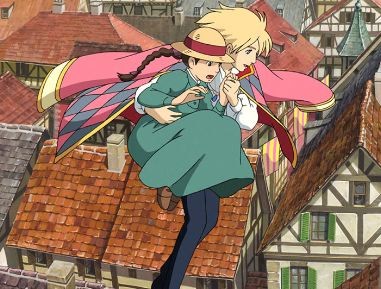Animated expression

Fairy tales tend to be parables. They teach us to look beneath the surface (Beauty and the Beast), to exercise patience and to work to overcome obstacles (Sleeping Beauty), to avoid easy gratification and hold out for the real prizes in life (Pinocchio). In the fairy-tale films of the great Japanese animator Hayao Miyazaki, the meanings are often layered.
It’s not hard to see the antiwar message in Howl’s Moving Castle. It’s set in an unnamed western European kingdom where a harebrained monarch wages a pointless war. The main plot, however, focuses on the relationship between a young woman named Sophie, who works at her mother’s millinery shop until the Witch of the Waste turns her into an old woman, and a handsome wizard, half man, half bird, named Howl.
This tale develops two themes—coming of age and acquiring wisdom—in unusual, quirky ways. Sophie’s transformation brings her unbidden—and certainly contrary to the witch’s intentions—the virtues that can accompany old age: feistiness, fearlessness that derives from long experience with the vicissitudes of life, the ability to see through nonsense, an appreciation for beauty and peace.
But surprisingly, Sophie isn’t the character who must come of age in this movie; Howl is. He’s kind, but vain and impulsive, with a penchant for running away from his problems; his ambulatory castle, a Rube Goldberg-like collection of clanking parts that wanders through the countryside on stilts and can take on the shape of a permanent house or a shop at Howl’s will, is a metaphor for his reluctance to commit himself to a goal or mission.
Through Sophie, he learns that there are things worth risking oneself for. He and Sophie, his young assistant Markl, and the fire demon Calcifer, who lights Howl’s hearth and keeps the castle on the move, become a family who look to him for leadership and protection.
Like Spirited Away, Howl’s Moving Castle may seem to ramble, because Miyazaki doesn’t always bother to set up the shifts in the narrative. (You can imagine him growing impatient with the beautifully crafted plot turns of the Harry Potter novels.) His ramblings always pay off, though, as when Sophie takes an excursion into the past and observes the genesis of the relationship between Howl and Calcifer that clarifies Howl’s character.
Much of the wonder of Miyazaki’s movies lies in these visual metamorphoses, which link his work to that of the master Hollywood animator Max Fleischer, a kind of Art Nouveau surrealist who is best known for the Betty Boop cartoons, and that of the French playwright-filmmaker Jean Cocteau, whose two finest films, Beauty and the Beast and Orpheus, are poetic fairy tales.
In some ways Howl’s Moving Castle is a mirror-image of Beauty and the Beast—the hero learns to love the cursed heroine. But in this film, there’s another character who labors under a curse: the unflappable scarecrow Turniphead, who devotes himself to Sophie when she rescues him from the underbrush. At the end we learn—no great surprise—that he’s a prince under an enchantment. In another movie he’d wind up with Sophie, but here she’s in love with Howl. Finally Turniphead declares, “Hearts change,” and returns to his kingdom. For Miyazaki, everything changes. In his movies, style and narrative are inextricably bound up together.
Most Americans will see the dubbed, Anglo-American version of Howl, which features Jean Simmons as Sophie, British actress Emily Mortimer as a younger Sophie, Christian Bale as Howl and Lauren Bacall as the Witch of the Waste. The only casting mistake is Billy Crystal as Calcifer; Crystal’s vaudevillian strategies feel out of place. Otherwise the dubbing is one of the film’s incidental joys.





